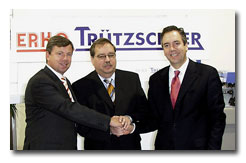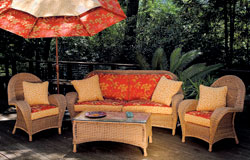R
obert Frost once said, “The best way out is always through.” For many years, the US
textile industry tried to go around, above and beneath to forge policies that were beneficial to
us. For many years, the industry also came up empty-handed or had policies thrown at us that were
detrimental to our companies and workers.
Finally, I think the industry has come to realize that if we are going to be successful, we
must go through Congress. And we must go through the administration and its myriad agencies if we
are going to forge policies that take our interests and the more than 600,000 workers we employ
into account.
In recognition of this new strategy,
the National Council of Textile Organizations (NCTO) was established almost 18 months ago in an
effort to mobilize the resources of our domestic textile industry more efficiently and
effectively.
 James W. Chesnutt is CEO of National Spinning Co. Inc., New York City, and chairman of the
James W. Chesnutt is CEO of National Spinning Co. Inc., New York City, and chairman of the
Washington-based National Council of Textile Organizations.
NCTO represents the entire spectrum
of the US textile sector — from fiber to yarn to finished product — as well as suppliers in the
textile machinery, chemical and other such sectors that have a stake in the industry’s prosperity
and survival.
I’ve been in textiles for more than 30 years now, and I’ve seen enormous changes during this
time — including changes in manufacturing philosophies and technology; changes in the way we market
our products as more and more businesses turn to the Internet; and, most importantly, changes in
global trading rules, which brought with them a revolutionizing change in the way trade is managed
in our sector and China’s move to quickly monopolize our industry.
First and foremost on anyone’s mind in the textile industry these days is China, as well it
should be. In the United States, China is shipping us 440 million garments a month — yes, 440
million garments a month. And that’s with safeguards in place.
With a US population approaching 300 million people, that’s 1.5 garments per person — and
this is happening every month. Over the course of a year, China will send us around 5.2 billion
garments. [T]hat certainly leaves me wondering what is left for the rest of us who want to continue
doing business in this sector.
Do any of us have a chance against China? Can any of us compete with this manufacturing
giant? The answer, of course, is yes, but it will require this industry and our government to be
bold and courageous by demanding that China play by the same set of rules as the rest of us.
The US government has worked tirelessly through the invocation of safeguards to prevent
China from monopolizing the domestic market in this sector. We currently have safeguards in place
for 10 product categories, and [as of] Jan. 1, 2006, a new textile and apparel bilateral agreement
between the United States and China [has taken] effect. All told, 34 categories of textile and
apparel products from China [are] now … controlled.
Because of this agreement, the US industry knows with certainty that China will not be able
to flood the US market during the next three years. The industry also will not have to rely on an
uncertain safeguard process with no guarantees. To be perfectly honest, I am still trying to
understand why China even signed this agreement. Regardless of its reasons, we are all breathing a
short sigh of relief now that this agreement is in place.
Unfortunately, this bilateral agreement and the safeguards are only a temporary solution to
the China threat. Under China’s WTO [World Trade Organization] accession agreement, the current
textile safeguard can only be used through 2008. After 2008, there is currently no mechanism by
which the US textile industry can hope to restrain imports from China.
We can’t use other trade remedy statutes like countervailing duty and dumping because of the
“like or comparable product” threshold. We make components, yarns and fabrics that do not meet this
threshold test. So once the safeguards are gone, our market will be wide open, and there will be no
recourse for us.
So are these safeguards just an exercise in futility — are we just delaying the inevitable?
I don’t think so, but as mentioned earlier, it’s going to require bold and courageous steps by the
US government and other governments around the world whose textile and apparel industries are
similarly at risk.
How can we work together to accomplish this? There are a couple of ways.
We believe it is imperative that the
China safeguard be extended or a new safeguard be created in the Doha Round of WTO trade
negotiations to prevent China from monopolizing world textile and apparel markets beyond 2008.
Absent such action, China will quickly grab a 70- to 80-percent share of the US market and paralyze
our industry, as well as those in other countries with significant textile manufacturing capacity.
Worldwide, this could translate into as many as 30 million people out of work and thousands of
textile and apparel plants shutting their doors forever.
A second but equally important issue involves tariff cuts for textiles and apparel in the
Doha Round. We must work together to ensure US textile tariffs are not included in the formula
approach advocated by China, [which] has proposed that US textile tariffs be dropped to 5 percent
or less while developing countries be allowed to keep their textile tariffs at 30 percent. If this
happens, the textile and apparel industry in the United States, and for that matter the entire
Western Hemisphere, will be destroyed.
The first step of this strategy requires that textile issues in the Doha Round be put into a
Special Textile Sectoral (STS) … that will enable textile issues concerning tariffs, nontariff
barriers and safeguards to be negotiated in a comprehensive manner.
Under a STS, textile tariffs would no longer fall under the formula approach in the
nonagricultural market access talks that would be so devastating for our industries. It would also
allow for a new safeguard to be developed to protect [the US textile industry from disruption due
to a massive influx of Chinese textiles] once the current safeguard expires.
As the Doha Round of global trade talks continues, it is imperative that key countries rally
together to demand that textiles and apparel be put into [their] own [separate] sectoral. If
textiles and apparel remain grouped together with other industrial products, then a new safeguard
will not be possible, textile tariffs will be slashed, and China will put us all out of business
beginning in 2009.
The threat is real, and the ramifications for all of us could be devastating. The worldwide
textile and apparel trade is at a crossroads, and it is up to us to ensure that the right road is
taken. A sectoral negotiation for textiles and apparel, a China textile safeguard beyond 2008, and
limited reduction in US textile and apparel tariffs are paramount if we want to live to fight
another day.
By working together, we can pave a road to the future for our industries. If we fail, there
is no future and the only road will be a one-way ticket across the Pacific for Chinese goods. Let’s
ensure this doesn’t happen.
January/February 2006








